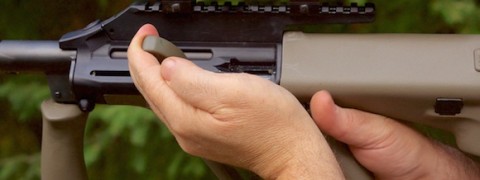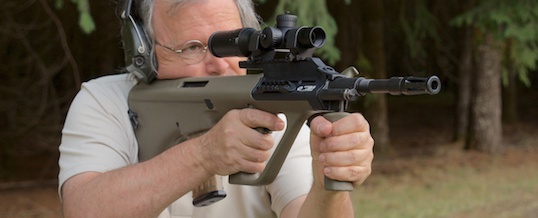
The Bullpup Rifle Experiment, Part 4: do they have a place in the home defense arsenal?
You can probably tell from the contents of this site, and from the books, videos and magazine articles I’ve done, that my focus is on a specific part of the shooting world: that of private sector self defense. I bring this up because there are big differences in the skills needed (and the way they should be taught) between this and the military, law enforcement, and competition parts of the shooting world. There is some overlap, of course, particularly when it comes to physical technique, but in general how and what we train are different from those other contexts.
It’s from this point of view that I evaluated the bullpup rifle. My interest wasn’t in whether it would make a good rifle for soldiers, police officers, or target shooters; what I wanted to know is if it had a place in the homes of the average citizen, the person who might need it to defend himself, his family, and his home against plausible threats. We already know that the rifle in general certainly has its place for that job, but what about the bullpup rifle — is it any better or worse at that job than the rifles we’ve come to know and appreciate?
Let’s start with a quick recap of the rifle’s place in self defense: the rifle is the tool that you choose when you’ve been made aware of a threat that:
- Happens beyond what you normally think of as handgun range
- Can benefit from more power than a handgun can deliver
- Needs greater precision than is easily achieved with a handgun
In contrast to the handgun, which is the tool we have on us for immediate response when a threat appears, the rifle is usually the tool we have to retrieve in order to deal with the threat. This is starkly different to military usage, where the rifle is the primary reactive tool; most people in the private sector don’t go out on patrol with their rifle slung, ready for action! (This is also different than a lot of law enforcement use, where the rifle is donned because they think they might need it and has to be easily dropped to physically control a suspect.)
Whether the threat is inside our home or outside, we’re just not likely to have the rifle in our hands and ready to go. We have to do several things which rarely get taught and even more rarely get practiced: get to it, make it ready to fire, and (often) take it to a position where we can actually employ it against the threat — even if that’s just across the room in a barricaded position. Only after all those things happen are we in a position to actually use the rifle; it’s in this context that I evaluated the bullpup for suitability versus the AR-15 that I currently use. How does the bullpup stack up?
When you consider the plausible use to which the defensive rifle is likely to be put, handling and maneuverability become important. Getting the rifle out of its storage space (which I certainly hope is a safe!) and into a condition which it can actually be fired is definitely helped by a short length — which is without a doubt the bullpup’s greatest strength. There’s a reason that Short Barreled Rifles (SBRs), built on AR-15 chassis, are so popular: they’re easy to work with. The bullpup rifle gives you an SBR-length package and all of its advantages, but with the ballistics and handling abilities of a full sized rifle. Getting the bullpup out and handling it in confined spaces is just easier than with a longer rifle, so the advantage here goes to the bullpup.
Readying the rifle, or loading and chambering the round, is easier with the common-pattern bullpup (those that roughly follow the pattern of the first successful design, the Steyr AUG) than with the AR-15. The forward charging handle of the common-pattern, in my estimation, is simpler to deal with than that of the AR (this from a person who’s been shooting and training with ARs for a couple of decades!) The position of the charging handle on most bullpups makes it easier to manipulate when the gun is on the shoulder, especially after a reload. This is one of the reasons I like the FN-FAL and have shot it so much over the years: it too has a forward charging handle on the left side of the rifle. I’ll give a point to the bullpup for this one, while recognizing that not everyone will find this particular control placement as compelling as I do.
Getting the rifle to the point where it can be employed definitely favors the short length (and neutral weight balance) of the bullpup rifle, especially if the rifle is needed in a perimeter defense role: keeping threats outside of a space where the handgun is more commonly employed. This usually means maneuvering around corners and through doors to gain outside access, and if you’ve never tried this with both a regular rifle (even an M-4 size) and a really short gun like a bullpup you won’t appreciate the difference. I can move a lot faster through my house and to the outside with the short bullpup than any AR-15 save an SBR. The bullpup easily picks up another point here.
What about using in an ensconced position, like in a safe room? Again, the length of the bullpup makes it easier to maneuver around furniture and the like; the neutral weight balance makes it a little easier to handle for extended periods of time. I’d rather have the bullpup for this job than my AR-15, though the race is a little closer than in some of the areas we’ve looked at.
In terms of long range precision, the bullpups generally suffer just a bit in comparison to a rifle like an AR-15 simply because of their military triggers. This varies quite a bit depending on the individual bullpup; the Tavor is without a doubt the worst I’ve used, the FN FS2000 the best, with the Steyr AUG in the middle. Of course this can be changed with aftermarket parts, but in their stock form they are a little harder to shoot than a typical AR-15.
That being said, I have relatively heavy triggers on my ARs (and FN-FALs) because I prefer a solid trigger press on a defensive rifle. My AR triggers are about 6-1/2 pounds, compared to the 9 lbs of the Steyr AUG I’ve been testing. Adapting to the heavy trigger of the AUG wasn’t difficult for me, but for those raised on match-grade triggers it may prove slightly difficult to manage. This can affect the achievable precision; for me it’s a fairly easy transition, but for others it might be an issue. As I said, all of the common bullpup rifles have commercial trigger modifications (or complete replacement triggers) available. Because they can be fixed if necessary, I’ll give the bullpup a half-mark in the disadvantage column for the trigger issues.
Being able to mount auxiliary sighting or lighting systems is a touch more difficult with the bullpup because of their reduced accessory rail space, but it can be done with careful selection on any of the bullpups I’m familiar with. No advantage, and perhaps a very slight disadvantage, to the bullpup.
One thing I’m not factoring into my recommendation is reloading speed, and that’s because I don’t consider it to to be of any importance. First, because it’s impossible to find an instance in private sector self defense where anyone had to reload a rifle to survive an incident; it just doesn’t happen, and I submit to you that 20 to 40 rounds of rifle-caliber ammunition is probably enough for any plausible (and most non-plausible) events! Second, because (as I noted last time) I didn’t see a real difference in reloading times once I’d adjusted my technique just a bit. For someone in a competition environment, where everything is optimized for a speed reload, that’s an issue; in self defense, it just isn’t.
Finally, we have to consider training and practice in any evaluation. There are, unfortunately, a lot of instructors out there with little to no bullpup experience who neither understand nor know how to deal with some of the training challenges that the bullpup rifle presents. If you choose a bullpup rifle as a defensive tool, you’re likely on your own for figuring out how to use the thing to defend yourself. As bullpup rifles become more common that will change, but for now understand that you’ll need to do a lot of work yourself as opposed to being able to get universally good instruction from any random instructor. This is a definite disadvantage to the bullpup, but also one that will change over time. It sure did with the AK-47!
Would I buy (or recommend buying) a bullpup as a defensive tool? Yes, with the training caveats mentioned above (along with some education as to design issues with specific guns.) There are some in the defensive training world who would criticize me for doing so, but largely because they probably haven’t learned enough about bullpup rifles to really be able to competently address their use. I don’t think they’re the perfect tool, any more than I think the AR-15 is the perfect tool. Looked at in terms of suitability for the task, however, they offer a compelling alternative to the conventional rifle.
– Grant Cunningham
- Posted by Grant Cunningham
- On October 7, 2015






